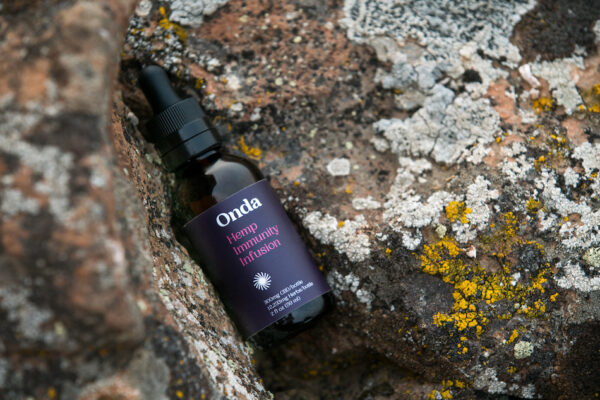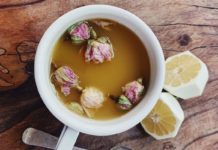Cultivating Balance and Resilience through Botanicals
Written by Jordan Douglas, HHC
As we celebrate the fall equinox and navigate the changing seasons in our ever-changing world, stress and immunity are at the forefront of many of our minds. The fall equinox is a time of balance and reflection. How do we cultivate inner calm amid outer chaos? How do we stay well in a pandemic? How do we build resilience in the face of stress? The plants, as always, have our back.
This is the time to focus on building vitality and resilience – strengthening our defenses (physical, mental and emotional) as we prepare for the winter ahead. One of my personal favorite tools is Onda’s Hemp Immunity Infusion – a delicious blend of whole hemp CBD and powerful plant allies echinacea, oregano, and elderberry. I enjoy taking a dropperful each morning to keep my immune defenses and nervous system strong, and to cultivate balance during this season of transition. Today we’re going to dig deep into the stress-immune connection, the CBD-immune connection, and the benefits of these botanicals.
The Stress-Immune Connection
All living things have co-evolved alongside a robust microbial community (bacteria, viruses, parasites, etc.). We’ve cultivated a beautiful symbiotic relationship with these microbes (e.g. our gut microbiome) and have also evolved to deter pathogenic invaders from entering our human host and track them down and destroy them once they have. Our two main mechanisms for executing these functions are the nervous system and the immune system. These two systems communicate back and forth to defend and protect us against pathogens (an entire science field is dedicated to this study called psychoneuroimmunology).
When we encounter a short episode of acute stress, our body mounts a protective immune response, increasing immune cell production to protect us against any potential threat. However, chronic stress depletes our immune response and can cause long-term changes to our immune system that render us more susceptible to infection and autoimmune disorders.
The Two Branches of the Immune System
There are two main branches to our immune system – the innate and the adaptive immune responses. These two branches are distinct and specialized to carry out their respective functions, but work together and complement each other to protect us against pathogens.
- The innate immune response is rapid and nonspecific. It includes our physical barriers (e.g. skin, mucus membranes) as well as immune cells that attack foreign invaders (e.g. neutrophils, natural killer cells called NKCs, dendritic cells, monocytes, and macrophages). The innate immune response works to prevent microbe entry, microbe colonization, and microbe spread.
- The adaptive immune response is more nuanced and specific and works over our lifetime to help our bodies adapt to the threat of reinfection. The adaptive immune response includes both humoral and cell-mediated immunity, and the key players and B and T lymphocytes.
Many of our innate immune cells stay on patrol, cruising around our circulatory system until their presence is requested in a specific organ or tissue, then they often return to circulation. Chronic stress disrupts this rhythm, altering the patrol-action pattern, and compromising our ability to respond to pathogenic threats optimally.
Let’s take a look at an example. Macrophages are white blood cells that play a critical role in all aspects of the immune response. Macrophages phagocytose (meaning engulf and destroy) foreign invaders; they also enlist the support of other innate immune cells (such as NKCs) and stimulate the adaptive immune response by expressing antigens. They are a significant workhorse of our immune system – they’re frontline boots on the ground, gobbling up anything that shouldn’t be there while also radioing back to base to get help, STAT. Macrophages are also highly sensitive to stress.
Chronic Stress on the Immune System
Chronic stress activates our HPA axis and triggers our sympathetic nervous system (SNS), also known as the fight-or-flight response, to constantly stay on (the fight-or-flight response is life-saving in acute situations; it is life-depleting when it remains activated). Staying with our macrophage example, here is what happens:
- Increased levels of epinephrine and norepinephrine (hormones released by the activation of the SNS) cause altered macrophage function, meaning fewer NKCs are mobilized to the target area.
- The cytotoxic effect of NKCs is also perturbed and the NKCs are less able to kill target pathogens.
- Macrophages then are less able to radio back to base for backup, meaning our adaptive immune response can’t sweep at full force.
- Combine this with the fact that chronic stress also causes a decrease in circulating T lymphocytes, and we’re faced with a situation where the organism is markedly less able to mobilize a defense response against pathogens [3].
Just a bit more pathophysiology for you: the humoral immune response involves antibody production. All cell types involved in this response have receptors for glucocorticoids (e.g. cortisol) and catecholamines (epinephrine and norepinephrine). In chronic stress, our HPA axis and SNS are chronically activated, leading to elevated cortisol and glucocorticoids. Elevation of these stress hormones alters the function of humoral immune cells and decreases titers of protective antibodies. With our adaptive immune response functioning sub-optimally in this manner, we can’t build memory and resilience in the same way.
Chronic stress negatively impacts our nervous system and immune system’s ability to communicate effectively and for our immune cells to function correctly.
Immunity and CBD
So, what does all this have to do with CBD? If you’ve been following along the Onda blog, you probably know how much cannabinoids and the endocannabinoid system (ECS) affect our stress response (and if you’re new, hi!, and here is a refresher, along with this one). Chronic stress disturbs homeostasis and adds to our allostatic load (the wear and tear on our body’s regulatory system). The ECS shines in maintaining homeostasis in the body and reducing our allostatic load.
But what about the immune system? Endocannabinoids and 2AG are found in our immune cells – namely basophils, lymphocytes, monocytes, macrophages, and dendritic cells. Phytocannabinoids (e.g. CBD, CBN) can also modulate the immune system’s activities and activate immune cells through receptor-mediated and non-receptor mediated approaches. The CB2 receptors, in particular, are associated with immune function, as they are expressed on immune cells and our nervous system’s microglial cells.
Remember those macrophages? It turns out they express high levels of CB2 receptors, along with monocytes and NKCs. Additionally, our endocannabinoids are thought to have an immunomodulatory effect in localized areas. Anandamide and 2AG influence immune cells’ function through autocrine and paracrine signaling on the micro-scale, translating to an overall fine-tuning of our immune system’s homeostatic balance on the macro scale [2].
More research is absolutely needed to elucidate the exact mechanisms of how all this works, especially CBD’s role. However, we know that taking phytocannabinoids (via a high-quality whole hemp CBD product like Onda) helps to tone our ECS and optimize its function, which could help optimize immune function. We also know that these same phytocannabinoids bind to CB2 receptors, which are found on both immune and nervous system cells, meaning good news for maintaining healthy immune and nervous system function.

Herbal Allies for Immunity and Resilience
Wondering what you can do to support your health and wellbeing, and how to keep your immune and nervous systems strong? Let’s go home to the plants. Plants have co-evolved with us over millennia, and our connection is deep and profound. The human answer to stress and pathogens has been to develop a robust immune-nervous system connection. Plants have responded to the same challenges with phytochemicals – secondary metabolites that protect them against stress and disease. When we consume plants – through both real, whole plant foods and herbal medicine – we’re consuming these phytochemicals that nourish us on a cellular level and enhance our physiologic functioning. Let’s take a look at three immune all-stars as well as our favorite, hemp.
Echinacea spp. – Echinacea
Echinacea has well-known antimicrobial, anti-inflammatory and immunomodulatory actions attributed to key secondary constituents such as caffeic acid esters, alkyl amides, and polysaccharides. Echinacea has antioxidant activity, as it is a source of beta-carotene, vitamin C, flavonoids, selenium, and zinc. Consistent clinical evidence supports the use of echinacea species for both acute (reducing symptoms and duration) and on-going support in a preventative capacity [1]. Echinacea is also a source of phytocannabinoids – alkyl amides found in echinacea are structurally similar to anandamide. Alkylamides, therefore, modulate immune function via CB2 receptors in monocytes and macrophages. Echinacea is particularly supportive of the upper respiratory tract, and overall raises WBCs (neutrophils, monocytes, eosinophils, B-lymphocytes), increasing phagocytosis [4].
Origanum spp. – Oregano
Oregano is another potent antioxidant, antiviral, and antibacterial botanical. Key secondary constituents include phenolics and terpenes, including rosmarinic acid, thymol, and carvacrol. The high levels of essential oils (re: terpenes) found in oregano act on the lung, bronchial tissue, and nasal mucosa rendering this herb particularly supportive to the and is supportive to the upper respiratory tract. Oregano is also aromatic and expectorant, moving stagnation and catarrh.
Sambucus nigra – Elderberry
Elder is a powerful antiviral, antioxidant and immunomodulator by containing anthocyanins, flavonoids, phenylpropanoids, cyanogenic glycosides, vitamin A and vitamin C. The elderberries are particularly supportive of catarrhal inflammation in the sinuses, lungs, bronchial, and the upper respiratory tract. Elderberry has been shown to play a role in the deactivation of several viruses (including influenza A and B) and shorten the duration and reduce the severity of colds and flus [5].
Activated Cannabis sativa – Whole Hemp™ CBD
Hemp is rich in cannabinoids, terpenes, chlorophyll, flavonoids and fatty acids. Here is a refresher on the benefits of beyond full spectrum whole hemp CBD. As an anti-inflammatory and antioxidant, hemp benefits our physiology in a myriad of ways. Cannabinoids work on the ECS, one of our leading players in maintaining homeostasis and regulating disease. Cannabinoids found in hemp help support healthy stress response, promote overall wellbeing and optimal physiological functioning, reduce pain and inflammation, and support immunity.
These four botanicals complement one another beautifully, supporting balance in the body and mind, keeping our immune defenses strong and helping us maintain a healthy stress response. Onda’s Hemp Immunity Infusion honors these herbs’ power and synergy for a delicious and efficacious way to support a healthy stress-immune-endocannabinoid connection.
You May Also Enjoy: Your Immunity Starts with Staying Balanced and Stress-Free
References:
[1] Braun, L. & Cohen, M. (2017). Herbs and natural supplements: An evidence-based guide. Churchill Livingstone, Australia: Elsevier
[2] Cabral, G.A. , Rogers, T.J., & Lichtman, A.H. (2015). Turning over a new leaf: cannabinoid and endocannabinoid modulation of immune function. Journal of Neuroimmune Pharmacology, 10(2), 193-203. doi: 10.1007/s11481-015-9615-z
[3] Dragos, D. & Tanasescu, M.D. (2010). The effects of stress on the defense systems. Journal of Medicine and Life, 3(1), 10-18. https://pubmed.ncbi.nlm.nih.gov/20302192/
[4] Hoffman, D. (2003). Medical herbalism. Rochester, Vermont: Healing Arts Press.
[5] Roxas, M. & Jurenka, J. (2007). Colds and influenza: A review of diagnosis and conventional, botanical, and nutritional considerations. Alternative Medicine Review, 12(1), 25-48. Retrieved from https://pubmed.ncbi.nlm.nih.gov/17397266/

About the Author
Jordan Douglas is a holistic health coach, budding herbalist, plant-based chef and soon-to-be nutritionist. She is currently completing her Master’s in Nutrition and Integrative Health, concentrating in Herbal Medicine from Maryland University of Integrative Health. Jordan has a profound passion for plants and their infinite capacity to nourish, heal and elevate every aspect of our being. Her mission is to support people on their journey toward cultivating optimal health through the power of plants. Through plant-based nutrition, herbal medicine and the healing power of nature, Jordan connects people and plants to ground in their relationship to self and elevate their health, well-being and consciousness.











